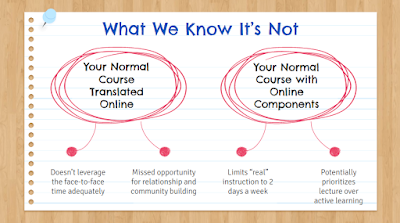This is Part 3 in a three-part series of blog posts on making decisions about what to teach live and in-person while working within a hybrid classroom. Visit the Part 1 post to read about integrating the in-person and online modalities and the Part 2 post to dive into different models of hybrid learning.
Learning Activities for In-Person vs. Online Instruction
As you begin to think about how to best structure your hybrid classroom, based on your content, students, and personal teaching style, the next step is to consider what activities are going to be best suited for in-person instruction. What are the activities that can be easily designed online for flexible student learning? How are you going to prioritize your limited live time with students?
Here are some ideas:
Possible In-Person Activities
- Hands-on activities
- Experiments
- Answering student questions
- Speaking and listening activities
- Small group instruction
- Socratic Seminar
- Debates
- Critical thinking and problem solving activities
- Conferencing and feedback with students
Possible Online Activities
- Active reading
- Videos
- Problem sets
- Discussion
- Assessment
- Peer feedback and review
- Projects
- Writing
- Reflection
Choosing In-Person Learning Activities based on Content or Curriculum
As I have shared in previous blog posts in this series, what you choose to do online versus in-person could be heavily influenced by the content that you are teaching. For elementary teachers, it may vary from one subject to the next. For secondary teachers, that means your class time may look significantly different from the teacher's down the hall. That's okay! Here are just a couple of examples that might get you brainstorming and reflecting about how to best maximize your in-person time within a hybrid model.
Special Area Classes or Career Preparation
An art teacher or a culinary arts instructor may find that there are simply some things they have to teach in-person because of the hands-on nature of their content. Other content they teach might be able to happen away from the classroom. For these teachers, they may find themselves in a hybrid model where half of their content is taught from introduction to assessment online and the other half is taught in-person.
World Language
I have spoken with several world language instructors who are taking different approaches to hybrid learning. Some are prioritizing the speaking and listening activities for their in-person instruction while teaching other content like grammar completely online.
Meanwhile, others are incorporating more of a reteaching model. In this model, most initial instruction happens online (flexibly completed both in-person and remotely), while the teacher spends their in-class time doing whole group or small group reteaching based on the data they receive from the online learning.
Social Studies
Many of the social studies teachers and elementary teachers I have spoken to have indicated that when teaching social studies, the live time with students for things like discussion, debate, and projects is critical. To prioritize these types of learning activities in the physical classroom, online learning is used as the foundation of the curriculum delivery.
Math
Math teachers around the country and world were already flipping their classrooms pre-COVID because it gave them the opportunity to work directly with students while they were applying the skills they learned. This flipped classroom model transitions well to a hybrid environment, allowing direct instruction to happen remotely and guided practice to happen in-person.
A small group model may also work well for math instruction. If the bulk of initial instruction is delivered online both while students are working remotely and in the classroom, teachers can use in-class time to meet with small groups. This small group instruction can be designed based on the data teachers collect from the online learning portion of the class.
Reading and Writing
So much of reading and writing instruction happens in small groups or through conferencing. To prioritize this time in-person, some direct instruction and independent and collaborative practice must happen online. Like all of the subjects mentioned above, when the online portion is designed intentionally to make learning transparent and to give the teacher data about what the students know and can do, that data can be used to maximize the limited time available in-person with students.
Final Thoughts
As you make these decisions about how to spend your live time with students, I encourage you to reflect on what your most important function is in the physical classroom and what tasks can be done really well leveraging technology.
Another question to reflect on might be "Why do you value in-person learning?" What are the things that make physically being in a classroom with students something that is hard to replicate or replace? And how can we align our learning activities to honor our priorities as instructors and the opportunities we want to create for our students, even if we have limited face-to-face time in the class?
As you begin to experiment with your personal hybrid model, I encourage you to seek out feedback, especially from your students. Ask them to share on a regular basis what is working well, what they wish they could do online, and what isn't working. They will be able to give you some incredibly useful insight about how to adjust your digital lessons. And if you incorporate their ideas, you will likely see boosts in engagement as students see that not only their opinion matters, but it directly impacts what learning looks like for them in the classroom.
Ultimately, don't be afraid to redesign when necessary. It's not going to be perfect, but we can continue to grow and iterate as we continue to create educational experiences for students that keep learning going no matter the environment.
I'd love to hear your thoughts about hybrid learning and what is working in your classroom. Share in the comments or on Twitter using the hashtag #PerfectBlendBook.














